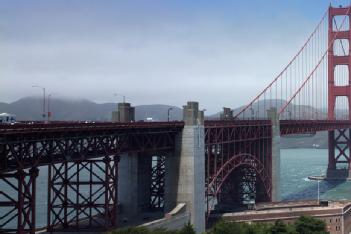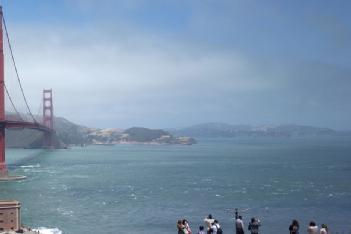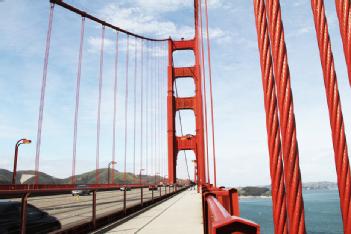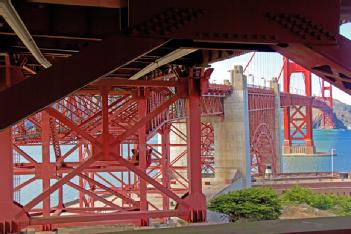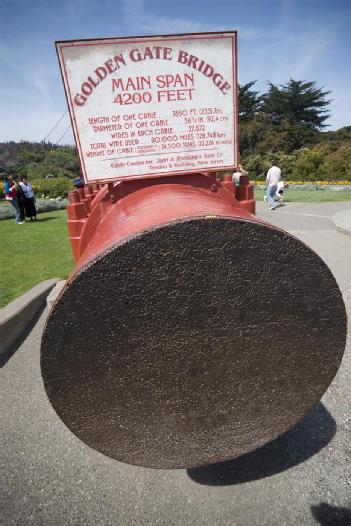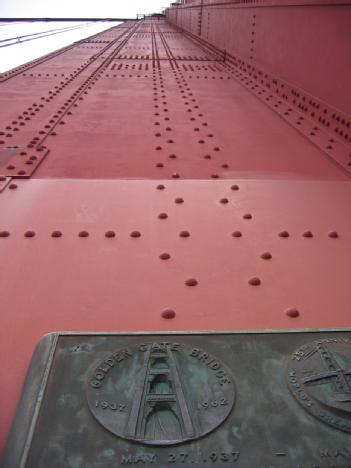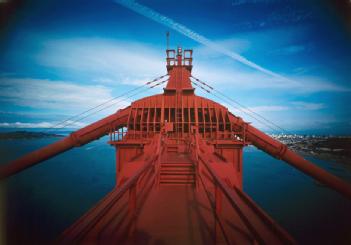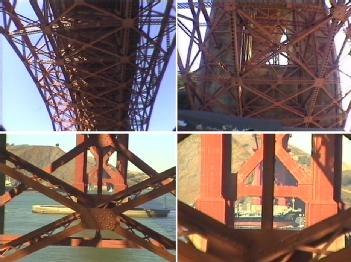
 |
Golden Gate Bridge |
94129-0601 San Francisco, CA, Estados Unidos (California) |
|
| Dirección |
|
| Superficie | No se conoce |
Puentes y Túneles
- Historic Engineering Landmarks
|
Horario apertura
|
Bridge Welcome Center: 9am - 6pm | ||||
|
Desde 02/2017
|
Tolls for vehicles see: http://goldengatebridge.org/tolls_traffic/toll_rates.php
free for pedestrians and cyclists |
||||
| Contacto |
|
||||
| Página web | www.goldengate.org | ||||
| Posición / Como llegar |
The Golden Gate Bridge is a suspension bridge spanning the Golden Gate strait, the one-mile-wide (1.6 km), one-point-seven-mile-long (2.7 km) channel between San Francisco Bay and the Pacific Ocean. The structure links the American city of San Francisco, California – the northern tip of the San Francisco Peninsula – to Marin County, carrying both U.S. Route 101 and California State Route 1 across the strait. The Golden Gate Bridge Visitor Plazais at the southeast side of the Bridge. To access the Visitor Plaza when traveling northbound, take the last San Francisco northbound exit from Highway 101. When traveling southbound on Highway 101, proceed through lane #1 (far right, west side) of the Toll Plaza and take the first exit on to Merchant Road. Make the first right turn and proceed down a small hill to the stop sign. Make another right turn on to the tunnel roadway that passes underneath the Toll Plaza. This feeds directly into the southeast parking lot.Please note: Parking is extremely limited at the Golden Gate Bridge and alternate means of accessing the Bridge and Visitor Plaza – bicycle, transit, rideshare, taxi, tour bus, etc. – are recommended! |
| Descripción | From Wikipedia, the free encyclopedia: Structural specificationsUntil 1964, the Golden Gate Bridge had the longest suspension bridge main span in the world, at 4,200 feet (1,300 m). Since 1964 its main span length has been surpassed by ten bridges; it now has the second-longest main span in the United States, after the Verrazano–Narrows Bridge in New York City. The total length of the Golden Gate Bridge from abutment to abutment is 8,981 feet (2,737 m). The Golden Gate Bridge's clearance above high water averages 220 feet (67 m) while its towers, at 746 feet (227 m) above the water, were the world's tallest on a suspension bridge until 1998 when bridges in Denmark and Japan were completed. The weight of the roadway is hung from two cables that pass through the two main towers and are fixed in concrete at each end. Each cable is made of 27,572 strands of wire. There are 80,000 miles (130,000 km) of wire in the main cables.[42] The bridge has approximately 1,200,000 total rivets. Traffic The movable median barrier between the lanes is moved several times daily to conform to traffic patterns. On weekday mornings, traffic flows mostly southbound into the city, so four of the six lanes run southbound. Conversely, on weekday afternoons, four lanes run northbound. During off-peak periods and weekends, traffic is split with three lanes in each direction The bridge is popular with pedestrians and bicyclists, and was built with walkways on either side of the six vehicle traffic lanes. Initially, they were separated from the traffic lanes by only a metal curb, but railings between the walkways and the traffic lanes were added in 2003, primarily as a measure to prevent bicyclists from falling into the roadway The Golden Gate Bridge Visitor Plaza |
[dsp_museum_detail.cfm]
| Cumplimiento de datos | Más información |
 goldengate.org
goldengate.org 

